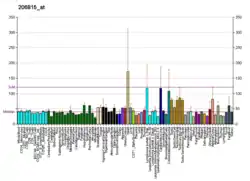Sperm-associated antigen 8
Sperm-associated antigen 8 is a protein that in humans is encoded by the SPAG8 gene.[5][6][7]
| SPAG8 | |||||||||||||||||||||||||||||||||||||||||||||||||||
|---|---|---|---|---|---|---|---|---|---|---|---|---|---|---|---|---|---|---|---|---|---|---|---|---|---|---|---|---|---|---|---|---|---|---|---|---|---|---|---|---|---|---|---|---|---|---|---|---|---|---|---|
| Identifiers | |||||||||||||||||||||||||||||||||||||||||||||||||||
| Aliases | SPAG8, BS-84, CILD28, CT142, HSD-1, SMP1, SPAG3, hSMP-1, sperm associated antigen 8 | ||||||||||||||||||||||||||||||||||||||||||||||||||
| External IDs | OMIM: 605731 MGI: 3056295 HomoloGene: 8250 GeneCards: SPAG8 | ||||||||||||||||||||||||||||||||||||||||||||||||||
| |||||||||||||||||||||||||||||||||||||||||||||||||||
| |||||||||||||||||||||||||||||||||||||||||||||||||||
| |||||||||||||||||||||||||||||||||||||||||||||||||||
| |||||||||||||||||||||||||||||||||||||||||||||||||||
| |||||||||||||||||||||||||||||||||||||||||||||||||||
| Wikidata | |||||||||||||||||||||||||||||||||||||||||||||||||||
| |||||||||||||||||||||||||||||||||||||||||||||||||||
The correlation of anti-sperm antibodies with cases of unexplained infertility implicates a role for these antibodies in blocking fertilization. Improved diagnosis and treatment of immunologic infertility, as well as identification of proteins for targeted contraception, are dependent on the identification and characterization of relevant sperm antigens. The protein encoded by this gene is recognized by sperm agglutinating antibodies from an infertile woman. This protein is localized in germ cells of the testis at all stages of spermatogenesis and is localized to the acrosomal region of mature spermatozoa. Alternatively spliced variants that encode different protein isoforms have been described but the full-length sequences of only two have been determined.[7]
References
- GRCh38: Ensembl release 89: ENSG00000137098 - Ensembl, May 2017
- GRCm38: Ensembl release 89: ENSMUSG00000066196 - Ensembl, May 2017
- "Human PubMed Reference:". National Center for Biotechnology Information, U.S. National Library of Medicine.
- "Mouse PubMed Reference:". National Center for Biotechnology Information, U.S. National Library of Medicine.
- Wang H, Miao S, Chen D, Wang L, Koide SS (Nov 1999). "Assignment of chromosomal locus and evidence for alternatively spliced mRNAs of a human sperm membrane protein (hSMP-1)". Biochim Biophys Acta. 1447 (1): 119–24. doi:10.1016/s0167-4781(99)00136-0. PMID 10500252.
- Liu QY, Wang LF, Miao SY, Catterall JF (Oct 1996). "Expression and characterization of a novel human sperm membrane protein". Biol Reprod. 54 (2): 323–30. doi:10.1095/biolreprod54.2.323. PMID 8788182.
- "Entrez Gene: SPAG8 sperm associated antigen 8".
Further reading
- Diekman AB, Herr JC (1997). "Sperm antigens and their use in the development of an immunocontraceptive". Am. J. Reprod. Immunol. 37 (1): 111–7. doi:10.1111/j.1600-0897.1997.tb00199.x. PMID 9138444. S2CID 39710127.
- Bonaldo MF, Lennon G, Soares MB (1997). "Normalization and subtraction: two approaches to facilitate gene discovery". Genome Res. 6 (9): 791–806. doi:10.1101/gr.6.9.791. PMID 8889548.
- Kuang Y, Yan YC, Gao AW, et al. (2001). "Immune responses in rats following oral immunization with attenuated Salmonella typhimurium expressing human sperm antigen". Arch. Androl. 45 (3): 169–80. doi:10.1080/01485010050193940. PMID 11111865. S2CID 218990195.
- Zhang XD, Miao SY, Wang LF, et al. (2001). "Human sperm membrane protein (hSMP-1): a developmental testis-specific component during germ cell differentiation". Arch. Androl. 45 (3): 239–46. doi:10.1080/01485010050194020. PMID 11111873.
- Strausberg RL, Feingold EA, Grouse LH, et al. (2003). "Generation and initial analysis of more than 15,000 full-length human and mouse cDNA sequences". Proc. Natl. Acad. Sci. U.S.A. 99 (26): 16899–903. Bibcode:2002PNAS...9916899M. doi:10.1073/pnas.242603899. PMC 139241. PMID 12477932.
- Tang X, Zhang J, Cai Y, et al. (2004). "Sperm membrane protein (hSMP-1) and RanBPM complex in the microtubule-organizing centre". J. Mol. Med. 82 (6): 383–8. doi:10.1007/s00109-004-0535-2. PMID 15014887. S2CID 21455758.
- Humphray SJ, Oliver K, Hunt AR, et al. (2004). "DNA sequence and analysis of human chromosome 9". Nature. 429 (6990): 369–74. Bibcode:2004Natur.429..369H. doi:10.1038/nature02465. PMC 2734081. PMID 15164053.
- Gerhard DS, Wagner L, Feingold EA, et al. (2004). "The status, quality, and expansion of the NIH full-length cDNA project: the Mammalian Gene Collection (MGC)". Genome Res. 14 (10B): 2121–7. doi:10.1101/gr.2596504. PMC 528928. PMID 15489334.
- Cheng GY, Shi JL, Wang M, et al. (2007). "Inhibition of mouse acrosome reaction and sperm-zona pellucida binding by anti-human sperm membrane protein 1 antibody". Asian J. Androl. 9 (1): 23–9. doi:10.1111/j.1745-7262.2007.00247.x. PMID 17187156.





